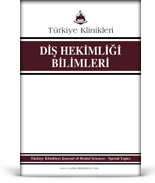Amaç: Bu çalışma, pilot bir çalışma olarak planlanmış ve OXIS sınıflandırmasında tanımlandığı gibi süt molar dişlerin farklı interproksimal temas alanlarının araştırılmasını amaçlamaktadır. Gereç ve Yöntemler: Bu çalışmada, 1 Aralık 2023-1 Şubat 2024 tarihleri arasında, Ondokuz Mayıs Üniversitesi Diş Hekimliği Fakültesine başvuran 3-8 yaş arası çürüksüz süt molar kontak yüzeyi bulunduran 75 hastanın 216 kontak alanı incelendi. Yapılan muayenelerde, kontak tipleri OXIS sınıflandırmasına göre O (açık), X (nokta), I (düz) ve S (kavisli) şeklinde kaydedildi. Kontak tipleri; yaş, cinsiyet ve bulunduğu çene kuadrantına göre değerlendirilirdi. Veriler, tanımlayıcı istatistiksel metotlar ve ki-kare testleri kullanılarak analiz edildi. Bulgular: Çalışmaya 43 kız ve 32 erkek toplam 75 hasta dâhil edildi. Kızlarda yaş ortalaması 5,3±1,6 erkeklerde ise 5,9±1,5'tir. Değerlendirilen 216 çürüksüz kontak alanından 115'i maksillada, 101'i mandibuladadır. En fazla gözlenen kontak tipi I (%64,8) olup, en az gözlenen kontak tipi S (%6) olarak belirlendi (p<0,001). Her iki cinsiyette de en fazla gözlenen kontak tipi I olurken, en az gözlenen erkeklerde S, kızlarda ise O tipi oldu (p=0,013). Yaşa göre değerlendirme yapıldığında; O tipi en fazla 3-4 yaş grubunda, X tipi 5-6 yaş grubunda, I ve S tipleri de 5 yaş üstü çocuklarda görülmüştür. Sonuç: Bu çalışma sonucunda, OXIS sınıflandırmasına göre süt molar dişlerde en fazla gözlenen kontak I tipidir.
Anahtar Kelimeler: Kesitsel çalışma; süt dişi; OXIS sınıflandırması; çocuk diş hekimliği
Objective: This study was planned as a pilot study and aimed to investigate different interproximal contact areas of primary molars, as defined in the OXIS classification. Material and Methods: In this study, 216 contact areas of 75 patients with caries-free primary molar contact surfaces between the ages of 3-8 who applied to Ondokuz Mayıs University Faculty of Dentistry between December 1, 2023 and February 1, 2024 were examined. In the examinations, contact types were recorded as O (open), X (point), I (straight) and S (curved) according to the OXIS classification. Contact types were evaluated according to age, gender and location. Data were analyzed using descriptive statistical methods and chi-square tests. Results: 75 patients were included in the study, 43 of them were girl and 32 were boy. The mean age in girls was 5.3±1.6 and 5.9±1.5 in boys. Of the 216 cariesfree contact areas evaluated, 115 were in the maxilla and 101 were mandible. The most common contact type was I (64.8%), and the least was S (6%) (p<0.001). The most common contact type in both genders was I, the least common was S in boys and O in girls (p=0.013). When evaluated according to age; type O was most common in the 3-4 age group, type X was in the 5-6, I and S types were seen in children over 5 years of age. Conclusion: As a result of this study, according to the OXIS classification, the most common contact type in primary molars is I.
Keywords: Cross-sectional study; deciduous tooth; OXIS classification; pediatric dentistry
- The Glossary of Prosthodontic Terms 2023: Tenth Edition. J Prosthet Dent. 2023;130(4 Suppl 1):e1-e3. [Crossref] [PubMed]
- Kirthiga M, Muthu MS, Kayalvizhi G, Krithika C. Proposed classification for interproximal contacts of primary molars using CBCT: a pilot study. Wellcome Open Res. 2018;3:98. [Crossref] [PubMed] [PMC]
- Muthu MS, Kirthiga M, Kayalvizhi G, Mathur VP. OXIS classification of interproximal contacts of primary molars and its prevalence in three- to four-year-olds. Pediatr Dent. 2020;42(3):197-202. [PubMed]
- Kirthiga M, Muthu MS, Lee JJC, Kayalvizhi G, Mathur VP, Song JS, et al. Prevalence and correlation of OXIS contacts using Cone Beam Computed Tomography (CBCT) images and photographs. Int J Paediatr Dent. 2021;31(4):520-7. [Crossref] [PubMed]
- Walia T, Kirthiga M, Brigi C, Muthu MS, Odeh R, Pakash Mathur V, et al. Interproximal contact areas of primary molars based on OXIS classification - a two centre cross sectional study. Wellcome Open Res. 2021;5:285. [Crossref] [PubMed] [PMC]
- Muthu MS, Kirthiga M, Lee JC, Kayalvizhi G, Mathur VP, Kandaswamy D, et al. OXIS contacts as a risk factor for approximal caries: a retrospective cohort study. Pediatr Dent. 2021;43(4):296-300. [PubMed] [PMC]
- Allison PJ, Schwartz S. Interproximal contact points and proximal caries in posterior primary teeth. Pediatr Dent. 2003;25(4):334-40. [PubMed]
- Kirthiga M, Tejasvi R, Srivarshani S, Muthu MS. Assessment of OXIS contacts-a comparison of three methods. Eur Arch Paediatr Dent. 2023;24(4):507-11. [Crossref] [PubMed]
- Kirthiga M, Muthu MS, Kayalvizhi G, Mathur VP, Jayakumar N. Variations in primary molar contact and approximal caries in children: a three-year prospective cohort study. Pediatr Dent. 2023;45(5):434-42. [PubMed] [PMC]
- Thekiya TSA, Walia T, Shetty RM, Berdouses ED, Hashim R, Al Jaghsi A. Variation of OXIS contact areas in primary molars among 3-6-year-old children with intraoral digital scanning. Eur Arch Paediatr Dent. 2024;25(3):433-41. [Crossref] [PubMed]
- Andrade C. Sample size and its importance in research. Indian J Psychol Med. 2020;42(1):102-3. [Crossref] [PubMed] [PMC]
- Muthu MS, Kirthiga M, Saikia A. OXIS contacts of primary molars: do they change over time? Eur Arch Paediatr Dent. 2024;25(5):663-8. [Crossref] [PubMed]
- El-Shamy H, Sonbul H, Alturkestani N, Tashkandi A, Loomans BA, Dörfer C, et al. Proximal contact tightness of class Ⅱ bulk-fill composite resin restorations: an in vitro study. Dent Mater J. 2019;38(1):96-100. [Crossref] [PubMed]
- Kirthiga M, Muthu MS, Kayalvizhi G, Mathur VP, Jayakumar N, Praveen R. OXIS contacts and approximal caries in preschool children: a prospective cohort study. Caries Res. 2023;57(2):133-40. [Crossref] [PubMed] [PMC]
- Subramaniam P, Babu Kl G, Nagarathna J. Interdental spacing and dental caries in the primary dentition of 4-6 year old children. J Dent (Tehran). 2012;9(3):207-14. [PubMed] [PMC]
- Aarthi J, Muthu MS, Kirthiga M, Kailasam V. Modified OXIS classification for primary canines. Wellcome Open Res. 2022;7:130. [Crossref] [PubMed] [PMC]
- Gupta S, Das A, Patra A, Saket A. Comparison of prevalence of oxis contact in primary maxillary and mandibular teeth: a retrospective cohort study. Ann Res Rev Biol. 2023;38(6):38-43. [Crossref]
- Kailasam V, Muthu MS, Rao U, C K, Kirthiga M, Aarthi J, et al. Prevalence of different types of interproximal contacts in the permanent dentition - a study cast evaluation. Wellcome Open Res. 2024;8:176. [Crossref] [PubMed] [PMC]







.: Process List